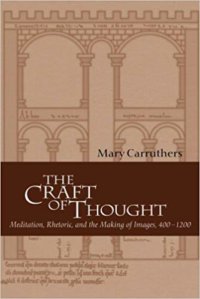The Craft of Thought: Meditation, Rhetoric, and the Making of Images, 400-1200

The Craft of Thought: Meditation, Rhetoric, and the Making of Images, 400-1200. Mary Carruthers. Cambridge: Cambridge University Press, 1998.
The craft of monasticism is to make prayer continuously based on the reading and recollection of sacred texts. This practice of mneme theou, “the meaning of God,” requires a memory that includes cognition, emotion, and imagination in the activity of recollection. In her book, The Craft of Thought, Mary Carruthers examines monastic meditation, “the craft of making thoughts about God,” and shows how monks invoke images and organized schemata, mixing visual media with words, in their practice of recollection. Meditation therefore is the craft of thinking, a type of recollection, to see the divine and recall God’s presence.
The book consists of five chapter with an introduction, bibliography, and pictures that illuminate Carruthers’ argument. Chapter one, “Collective Memory and Memoria Rerum,” examines the invention of memory, showing how orators created the means to invent material when needed. Carruthers explains how invention (inventio) meant to create something new (like the image of a building to place memories for storage) and to be an inventory where memories are ordered and organized so as to be accessed anytime. It is the remembering of something when invention is employed to assist a person to recall the subject matter and how it was organized in his or her mind. Carruthers concludes the chapter with an examination of collective memory and how it changes over time, with the key being not society forgetting but transforming something to be remembered differently in a closely related story.
Chapter two, “Remember Heaven: The Aesthetics of Mneme,” focuses on John Cassian’s Conferences as an essential foundation of monastic rhetoric. Cassian’s dialogues on the method of prayer and reading influenced subsequent Christian theologians, especially Benedict of Nursia and Gregory the Great. Rules of mnemotechnical practice included pairing the author’s and audience’s judgment, the division of text into segments that could be memorized, and the use of images to be associated with things to be remembered. The ancients and medieval believed memory was critical for human flourishing and that it was central to molding a person’s character. How one remembered could determine one’s conversion, forgetfulness, or salvation.
Chapter three, “Cognitive Images, Meditation, and Ornaments,” looks at the nature and function of mental images and how recollection affects the style of oration, whether enargeia (bringing-before-the-eyes), paronomasia (punning), or allegoria (difficulty). Unlike the moderns, the ancients and medievals made no distinction between visual and verbal in their recollection: images, along with words, served as cues to the subject being known and pointed to something else besides themselves. The use of sensuous word-painting (enargeia) engaged all the senses to assist one to remember; the construction of puns (paronomasia) was another technique; and the associative power of things (allegoria) was a third. These and other techniques are the tools for medievals to make their own buildings of memory.
Chapter four, “Dream Vision, Picture, and ‘The Mystery of the Bed Chamber,’” explores how the ancients and medievals use mental images (“visions”) to start and sustain a story (e.g., Boethius’ lady of philosophy, monastic visions like of Wetti, Gregory the Great’s The Life of Saint Benedict). All of these visions were recollections, a use of one’s imagination, emotions, and thought, to convey a story with an underlying moral or religious lesson. The vision is a picture that acts as a trope of classical and monastic rhetoric, providing elucidation and education to those who recall it and those who listen.
Chapter five, “The Place of the Tabernacle,” focuses on the building themselves of monastic rhetoric and how the various components that consist of the process of recollection come together. Examining an array of imaginary buildings, Carruthers show how they function as part of meditation and liturgical prayer. The monastery and its mental buildings therefore are tools to help people to pray continuously in the hope to see God.
Carruther’s The Craft of Thought is an important contribution to our understanding of memory, the medieval world, and how our image of the world today both converges and diverges from our past. By showing how medieval monastic meditation influences literature, art, and architecture, The Craft of Thought underscores the importance of memory in bringing these disparate disciplines together as a unitary whole. Remarkable and learned, The Craft of Thought is a book to be read and recollected again and again.




